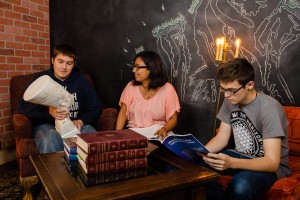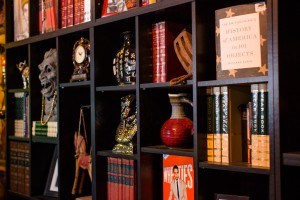Encouraging the Unconventional

Encouraging the Unconventional
Chris Cumiford
2012 MA in World History
History Teacher for Visalia Technical Early College (VTEC) High School
In 2015, Chris was named Tulare County Teacher of the Year, and in 2016, he is one of the top 10 teachers in California. His approach to teaching history is interesting, creative and different than most of the history teachers we all remember. Chris’s story is being featured in the 2016 spring issue of Pacific magazine, so we thought you might like to hear what he had to say when he sat down with one of our student writers.
Q: What inspired you to work with high school students?
A: My first teaching experience was at a charter school, Charter Alternative Academy. The student body was made up of expelled students from 7-12th grade. It was a challenging assignment because I was working with students who had mild to moderate learning disabilities and all were expelled. It turned out to be a great start for me because I was able to learn a lot of engagement strategies that needed to be used for those students in the classroom who struggled academically and socially.
I knew I had the toughest assignment in the district because they were all expelled, but I really thrived in that environment. I didn’t really know any better, because it was my first teaching assignment. I was just happy to be in education.
Beginning with that experience, I sort of bonded with the high school age group. I decided that I really wanted to work with them. I wanted high school students to get excited about history, and see that past differently.

Q: Was there an FPU professor that was particularly influential?
A: Marshall and Pam Johnston were influential FPU professors that shaped the way I think about history as a field of study and teaching in general. I think the thing I’ve learned the most from them is their passion for the subject and patience for students. They have a positive way of interacting with students that makes them feel included and cared for. I know I felt this way as one of their students.
Q: What values do you uphold in your teaching?
A: I want to get students excited about the past, and I think it is powerful to allow students the opportunity to realize that they are creating the past. They don’t often think of it that way. From their perspective it’s like, you go to history class, you reflect on what’s happened. I mean, at this very moment we are creating what will be the past. I think that is really powerful!
It’s important to stop and look inward. I want students to slow down in the busy world we live in. The culture is always going to evolve and change, but we should be able to think about the decisions we are making with a critical eye. I want students to be reflective and to think reflectively when they’re analyzing material whether it’s World War I or whatever we’re studying. The historical people can become real to them and that’s powerful.
Q: What did you learn at FPU that helps your work today?
A: The patience one is really big and to be a critical thinker, but what excited me the most, which is something I got through the whole program at FPU, was this excitement that every day you show up to teach a class, you are, for a brief moment in time, able to bring back these people and these stories. Because inevitably, it’s the people. It turns out that people who lived a long time ago were not so different from us; they had passions and fears that they were driven by so that connection is huge.
Thankfully we’ve moved away from just dates and the memorization of things. To be able to bring back historical content in the classroom is the highest honor I feel that I can give to the past generations. This can be in many forms from written material or physical objects, but putting students in the role of historians, and allowing them to conceptualize the information through their lens is important. If we are reading a primary source document, students are transported back into their lives and have this connection. I see those moments happen, and I feel like it’s my job to be able to use every creative tool I have to take this current generation and the past generations and bridge the gap, so that we can learn and continue to be inspired by people from the past.
Q: Any concluding thoughts?
A: I want to be able to inspire teachers to reach students at high levels through engagements strategies and creative design. As educators, we have opportunities to design engaging lessons and projects that can foster a lifelong love of learning. Teachers should be encouraged to utilize unconventional methods of teaching that inspire students. This can take place inside the classroom, but can also take place out in the field through various elements of hands-on research.
Leonardo Da Vinci is an inspirational figure for me, he is usually on my mind when I am thinking about education. His philosophy on combining science and art, logic and creativity were essential parts of his foundational approach to life. He pushed these boundaries in every direction through firsthand experience. This is what people want today. Real lived experiences that combine depth and beauty. This is the kind of learning Da Vinci was after. He was into anatomy and mathematics, botany and engineering. For me, when Da Vinci says, “Make science your art and art your science,” I’m really trying to live that approach.

By Makenzie Dunckel (BA ’16)




